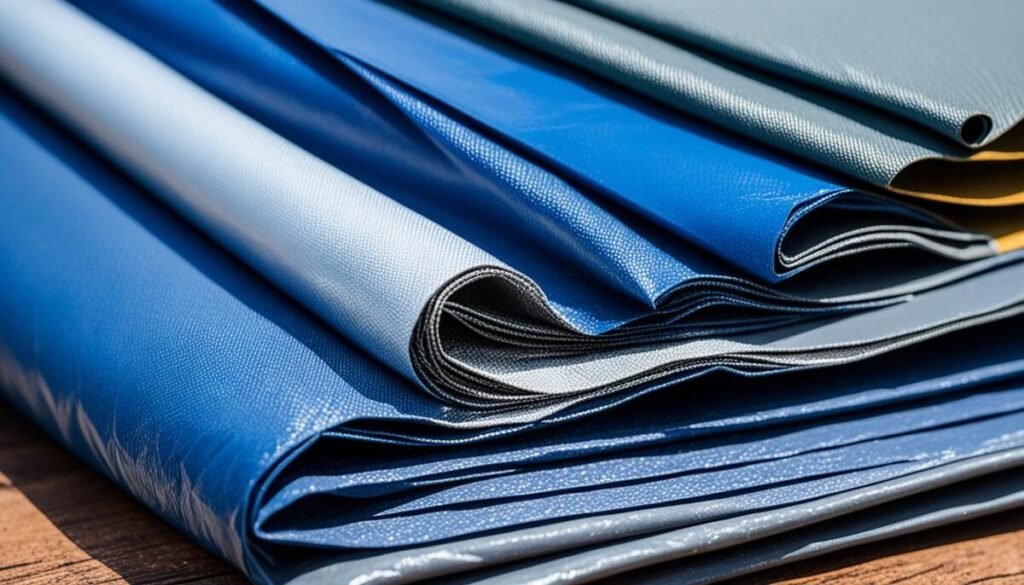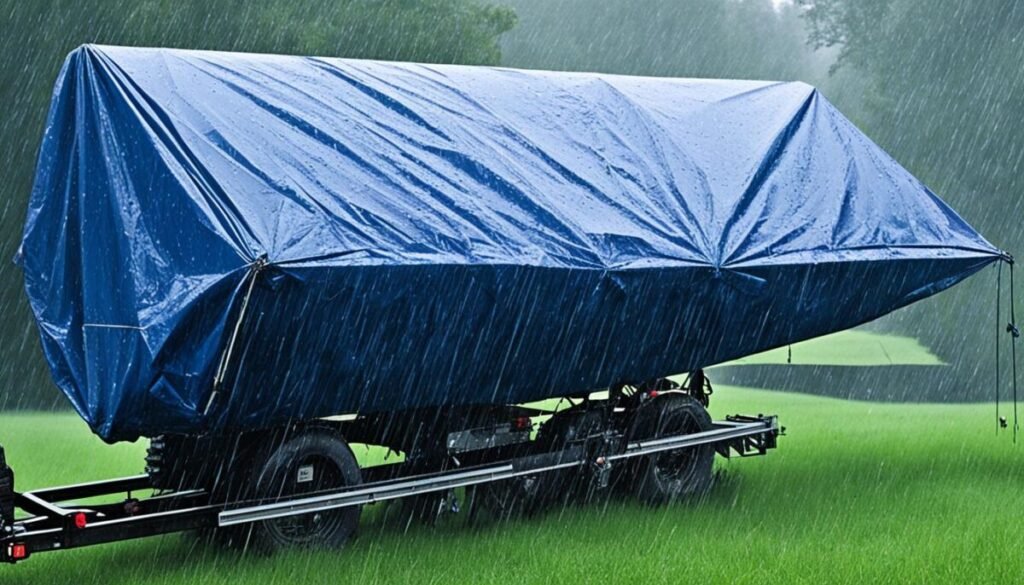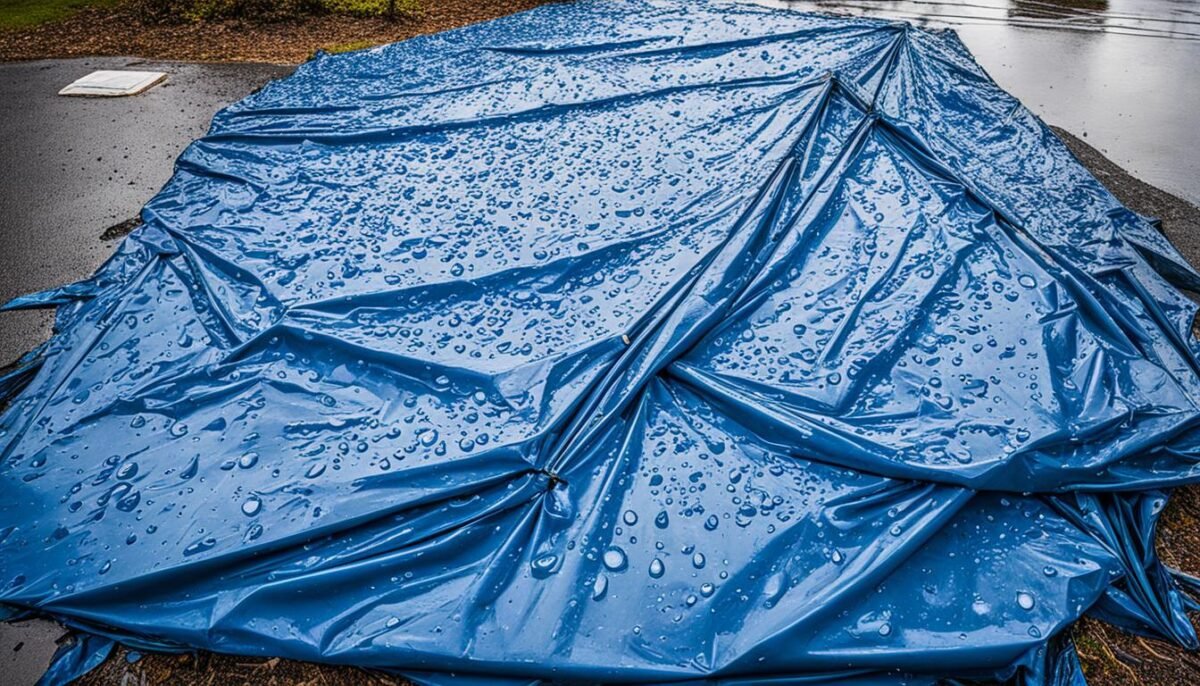In this article, we will not only answer the question, but also unpack what to look for in purchasing a waterproof tarp for outdoor use for your home emergency kit.
- Not all tarps are waterproof: Their water-repelling ability depends on material and design.
- Material matters: Durability and waterproofness vary, with polyethylene, vinyl, and treated canvas being top choices.
- Durable waterproof tarps protect and last: They’re essential for safeguarding against rain and extending the lifespan of covered items.
- Check before you buy: Evaluate waterproof capabilities when selecting tarps for outdoor or a waterproof tarp for camping
- Strategic selection is key: A robust tarp is crucial for effectively protecting assets in adverse weather.
Table of Contents
Are Tarps Waterproof? Evaluating Common Types
When it comes to understanding the waterproof capabilities of tarps, one must consider that its effectiveness can significantly vary based on the design and material composition. Accurately identifying how to choose waterproof tarps becomes an essential task for those seeking superior protection against the elements.
Insights gathered from various outdoor and boating forums indicate that even a well-fitted tarp or boat travel cover might not always guarantee absolute protection against harsh weather conditions.
“There’s more to a tarp than being merely a cover. The material, design features, and measurements all contribute to the effectiveness of a tarp.”
Boating enthusiasts who have traveled long distances frequently testify the importance of choosing covers with softer materials on contact points. This smart choice aids significantly in preventing paint wear.
In an added effort to mitigate air build-up while on the road, a good cover designed with vent holes is highly recommended by frequent travelers and outdoor adventurers. This feature underscores the significance of tarp traits in their ability to repel water. As various users discuss the perceived mileage improvements when towing boats with covers, it sheds light on the practicality of waterproof tarp options .
Nevertheless, the protective role of tarps is widely recognized. They are especially known to guard against dirt, debris, and potential rock damage, underscoring their value beyond just water resistance. Therefore, understanding the different types of tarps with their respective features becomes crucial while choosing the right one to cater to your specific needs.
Durable Waterproof Tarps for Emergency Kits
In emergencies, big, waterproof tarps are essential for two things: making shelter and collecting water. These versatile sheets, often made from tough materials like polyethylene or vinyl, are crucial tools for keeping safe from the elements.
Making Shelter
When you’re in a tough spot like a natural disaster or camping emergency, having a waterproof tarp can really help. These tarps keep out rain, wind, and other harsh conditions, giving you much-needed protection.
By tying a tarp securely between trees, poles, or other sturdy things, you can quickly build a shelter to hide from the rain or sun. Tarps can be set up in different ways, from simple A-frames to more complicated setups, depending on what you have and what you need.
Collecting Water
Along with providing shelter, waterproof tarps are great for collecting water in emergencies. By setting up a tarp to catch rainwater, you can gather water for drinking, cooking, and cleaning.
To get the most water, make sure the tarp is angled slightly to let water flow into a bucket or container. Also, keep the tarp clean and securely tied down to keep the water safe and prevent it from getting dirty.
In summary, big, waterproof tarps are vital tools in emergency situations. Whether you need shelter or water, these versatile sheets are indispensable for staying safe and prepared when things get tough.
The Characteristics of Waterproof Tarp Materials

In the world of tarps, there’s an important distinction to be made between the simple terms ‘water-resistant’ and ‘waterproof’. The level of water repellency can significantly vary depending on the tarp’s material makeup and design, influencing its performance when exposed to moisture. As prospective buyers or users, understanding these differences can help you make informed choices and maximize your investment in the top-rated waterproof tarps.
Differentiating Between Water-Resistant and Waterproof
Often, people use ‘water-resistant’ and ‘waterproof’ interchangeably, but in reality, these terms represent two different levels of water protection. A water-resistant tarp, for instance, can only slow down the process of water penetration. In contrast, a true waterproof tarp material should completely prevent water from breaching the tarp’s surface.
Types of Materials Used in Waterproof Tarps
Materials influence the waterproof properties of a tarp. Although canvas may provide a degree of water resistance, it requires specialized treatments for full waterproofing. Among the best waterproof tarps, certain materials stand out for their superior water barrier properties:
- Polyethylene: This common synthetic material is prized for its durability and affordability. It is resistant to many substances, including water, and can withstand both sun and wind.
- Vinyl: Much like polyethylene, vinyl is durable and resistant to many elements. It is also flexible, making it ideal for tarps that need to be fitted snugly.
- Specialized Canvas with Waterproof Coatings: While traditional canvas is not naturally waterproof, certain coatings can make it so. This enhances the canvas’s durability and functionality under varied weather conditions.
The Role of Thickness and Density in Waterproofing
Thickness and density are two crucial factors that contribute to a tarp’s waterproofing abilities. Denser and thicker tarps usually provide better water barrier properties, withstanding weather conditions better and being more durable over time. When selecting a tarp, consider not only the material but also its thickness and density, as these attributes will directly impact its performance against wet conditions.
In conclusion, understanding the differentiating factors between waterproof and water-resistant tarps, along with their materials and features, is essential for users seeking full protection against moisture. As shared by some users, a well-chosen waterproof tarp that aligns with your specific needs may very well be the unsung hero in your outdoor adventures or professional endeavors.
Advantages of Using Durable Waterproof Tarps

Among the several benefits conferred by durable waterproof tarps, paramount is their unwavering defense against natural elements such as wind and rain. They perform the crucial role of safeguarding our cherished possessions by providing a robust shield against water damage and detrimental wear caused by fluctuating weather conditions.
Protection from the Elements: Wind and Rain
One of the key assets of durable waterproof tarps is their resilient structure that can effectively withstand and ward off adversities like wind and torrential rain. The assurance brought along by these heavy-duty tarps—their ability to prevent water incursion—can significantly lower potential worries surrounding climate-induced spoiling of treasures, whether it may be machinery, vehicles, or other outdoor essentials.
Enhanced Longevity and Versatility
Quality waterproof tarps display remarkable durability and adaptability, factors that contribute to their extended lifespan and wide applicability. Their robust build enhances their longevity and ensures their ability to endure various outdoor conditions, enriching their versatility for industrial uses and recreational outdoor activities. The ruggedly reliable nature of these tarps, along with their ability to serve multiple needs, sets them apart as a worthwhile investment.
Cost-Effectiveness of Durable Solutions
Another deciding advantage of reliable waterproof tarps is their cost-effectiveness. The tangible savings they offer spring from their potential to persistently hold up against harsh conditions, reducing the need for frequent replacements, and thereby, containing costs. From the experiences recounted by avid boaters and travelers, we learn that a reliable waterproof cover can offer additional perks, including enhanced gas efficiency, prevention of theft, and upkeep of cleanliness for transported goods. These savings, both direct and indirect, render durable waterproof tarps a cost-effective solution for varied needs.
Waterproof Tarp for Outdoor Use: A Buyer’s Guide
When purchasing a waterproof tarp for outdoor use, many factors should be considered carefully. Be it camping or just garden usage, a waterproof tarp that suits your needs should be selected.
The choice of tarp should primarily be influenced by specific usage needs such as protection level against rain, durability, and ease of handling. Given a pool of options, pinpointing key features such as ultraviolet (UV) protection, grommet placements, and reinforced corners can enhance the performance of a tarp.
Tarps designed for outdoor adventures should display strength without foregoing portability. They should be durable and robust, capable of taking on harsh weather conditions. Meanwhile, they should also be lightweight and easy to carry around for convenience.
Given the feedback from individuals who have contended with severe weather, personal experience indicates that a tight-fitting tarp made from high-density polyethylene (HDPE) or vinyl would be extremely efficient in safeguarding against environmental challenges.
- Size: Consider the extent of area or object to be covered. A larger tarp might be necessary for covering a picnic area or an RV, while a smaller tarp could suffice for a camping tent or garden furniture.
- Material: Know the strengths and weaknesses of different tarp materials. While HDPE and vinyl tarps can provide excellent waterproofing, they may not have the same breathability as canvas or cloth tarps.
- UV protection: Some tarps come with special coatings to block UV rays, which can degrade and damage the material over time. This can be a key factor if the tarp will be used in a sunny location.
- Grommet strength and placement: The grommets should be sturdy and rust-resistant. Also, they should be adequately spaced along the tarp’s edge to secure it effectively.
- Corners and edges: Reinforced corners can make the tarp more durable and resistant to tearing, particularly when it is tied down tightly.
In conclusion, knowing how to choose waterproof tarps can make a significant difference in achieving your outdoor objectives, whether they include camping, boating, or just protecting your outdoor barbecue. So, look for key features suitable for your needs and make an informed decision.
Top-Rated Waterproof Tarps and Their Applications
When it comes to protection against the elements, whether in recreational activities or heavy-duty industrial contexts, waterproof tarps play an undeniable pivotal role. Distributing themselves across a broad spectrum of applications, these top-rated waterproof tarps consistently demonstrate their efficacy and adaptability in various environments. Looking through the lens of user testimonials and practical experiences, we can explore why waterproof tarps have become indispensable protection tools.
Best Tarps for Camping and Recreational Use
In the realm of camping and recreational use, tarps need to be both rugged and compact. The best waterproof tarps help craft a dry, comfortable living space, repelling water efficiently while still being lightweight and easy to deploy. Imagine sitting cozy inside your tent, listening to the rain patter on your waterproof tarp, without a drop seeping through — that’s the kind of assurance and peace of mind top-rated waterproof tarps offer.
Industrial and Construction Applications
Industrial and construction settings demand stringent protective measures. Here, the waterproof attribute of tarps becomes a prerequisite. Protecting expensive machinery and materials from precipitation and ambient moisture can mean the difference between an incessantly disrupted work schedule and a smooth, efficient operation. When tarps can provide a reliable line of defense against weather-related setbacks, their importance cannot be overstated.
Marine and Automotive Uses
Tarps in the marine and automotive domains fulfill a vital role, with robust waterproof covers ensuring that vessels and vehicles remain unblemished during storage or transport. Ensuring paint and essential components don’t suffer the ravages of inclement weather is a must. In the wider context of long-haul transport, user testimonials attest to improved fuel mileage and even deterrents against theft when a well-fitted, waterproof tarp is employed — a multifaceted solution that underlines the diverse applications of these essential protective materials.
How to Choose Waterproof Tarps for Long-Term Use
In the pursuit of procuring durable waterproof tarps, one must carefully evaluate the tarp’s material durability. Here, pivotal aspects include a high denier count and robust coatings that ensure the tarp’s resilience under the sun’s merciless rays or during heavy rain. Analyzing such features is essential when evaluating how to choose waterproof tarps that deliver long-term benefits.
Furthermore, the construction of seams and the application of weatherproof treatments directly impact a tarp’s lifespan and overall effectiveness. Taking into consideration long-term use, it becomes paramount to heed the real-world experiences shared by many individuals in forums and review segments.
“Investing in durable, heavy-duty waterproof tarps has significantly enhanced the longevity of our outdoor gear. Since we started using these tarps for camping, we no longer worry about our belongings getting wet or damaged, no matter the intensity of weather conditions. The benefits truly outweigh the initial investment.”
Such testimonials lay emphasis on the importance of thoughtful consideration of certain post-purchase factors such as maintenance needs, repair ease, and adaptability to different environments—be it the wilderness of camping grounds or the hustle and bustle of industrial sites.
Deciphering how to choose waterproof tarps for long-term use involves contemplating the following key aspects:
| Aspect | Explanation |
|---|---|
| Material Durability | The tarp should be built with high-quality materials that are robust enough to withstand harsh environmental conditions. |
| Seam Construction | The approach and method used in seam fabrication effect the tarp’s long-term performance. |
| Weatherproof Treatments | A well-treated tarp offers superior weather-resistant capabilities, extending its effective lifespan. |
| Essential Post-Purchase Factors | Understanding the aspects of maintenance, ease of repair, and adaptability enables users to make a well-informed decision for prolonged use. |
Overall, these aspects collectively guide any potential buyer through the overwhelming maze of options available in the ever-growing market of durable waterproof tarps.
Conclusion
In wrapping up this discussion, it’s clear that answering the question: “Are tarps waterproof?” isn’t as straightforward as one might expect. The waterproof capabilities of tarps differ based on material composition, design, and intended function and are critical in preserving and protecting valuable possessions. Equally important is selecting the right tarp. It’s essential to go beyond immediate needs and choose a tarp with durable features and a promise for long-term performance. Let’s look at a summary of the topic, some final recommendations for tarp selection and use, and a call to action for the audience.
Summarizing the Waterproof Capabilities of Tarps
The discourse among users indicates that while certain tarps are inherently designed to be waterproof, others only offer water resistance. This distinction prompts the need for cautious consideration when buying a tarp. High-quality, best waterproof tarps made from materials like polyethylene, vinyl, and specialized canvas with waterproof coatings provide excellent water barrier properties. Understandably then, these tarps have found extensive application in a variety of areas, from boating and camping to construction and industrial scenarios.
Final Recommendations for Tarp Selection and Use
When it comes to tarp selection, I recommend that buyers evaluate not only the immediate need but also consider factors such as durability and ease of repair. Simply put, understanding how to choose waterproof tarps is just as crucial as having a good understanding of the different waterproof tarp options available in the market. Make sure it’s made from a suitable material, has top-notch construction, and features weatherproof treatments, especially if you intend to use it for extended periods.
A Call to Action for Sustainable Practices
Finally, let’s not forget that as convenient as they are, tarps also come with their environmental implications. As users, it’s our duty to engage in sustainable practices. This includes but isn’t limited to responsible tarp disposal, seeking recycling opportunities, and embracing reusability wherever and whenever possible. There’s immense value in promoting environmental consciousness alongside the practical utility tarps serve. Remember, being environment-friendly doesn’t end with selecting the best waterproof tarps; it extends to how we use and dispose of them.


